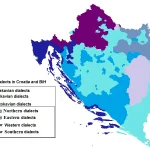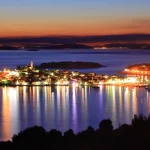For such a small country, Croatia has numerous transport options which are generally very good. An array of bus companies, both domestic and foreign, operate on Croatia’s roads, and while Croatian trains are another kettle of fish entirely, bus, maritime and even domestic air connections and the ease of which public transport generally works is praiseworthy for such a small nation which doesn’t exactly have huge sums of cash to blow on it.
Bus services
Jumping on a bus in most places across Croatia is often the most efficient way of getting from A to B, and to a few other letters should you so wish. Croatia’s overall bus network is extremely comprehensive, and even the smallest villages are usually still connected. This is very impressive when you think of far richer countries such as the UK which has horrifically poor bus connections the further north you move, with some rural villages being almost entirely cut off.
Generally faster than the train (for reasons we’ll delve into later on), buses are the main travel choice for tourists and locals alike. Journey times are mostly reasonably quick on direct routes, but do be aware that bus journeys from let’s say… Dubrovnik to Zagreb, do take a while. Nobody can do much about that distance.
Online information on bus options is constantly improving and has done quite remarkably over the last few years, as is the option of buying tickets online. Expect to stop at least once on longer journeys, which will be welcome news for smokers, those who really need to stretch their legs and those in need of a toilet.
From Flixbus to Čazmatrans, a fantastic way to learn all you could possibly want to know about bus services in Croatia, from local lines which get you from A to B to large companies taking you to one end of the country and back again or indeed outside of its borders, is to pay a visit to the website Get By Bus (getbybus.com), and then enter ‘Croatia’.
Trams
Zagreb’s trams are without a doubt the most famous Croatian trams, but there is another city which boasts this handy and very environmentally friendly method of getting around too – Osijek. Trams were once present in both Istria and Dalmatia, with a very beloved (and very charming) one once operating down in Dubrovnik, but unfortunately they are a thing of the past.
As touched on above, the City of Zagreb has a very well developed central electric tram network called Zagreb Electric Tram, or ZET for short. These trams are generally blue, but also come in other colours, and sometimes with imagery promoting everything from Zagreb University to Gavrilović meat products. They make their way through the streets in all directions like a steel snake slithering through a concrete jungle during the day and late into the night. You can get from just about anywhere to anywhere else in Zagreb using the tram network, and timetables can be found at tram stops dotted all over the city or by visiting ZET’s website (zet.hr), and selecting English (EN) as your preferred language.
It’s worth noting that ZET also runs Zagreb city bus services, and those buses are of course also blue.
Further east in the City of Osijek, the only tram network still in existence outside of the capital is a favourite method of public transport. Having begun way back in the 1880s as a horse-car tram line, this way of getting around is still going strong. All information and timetables can be obtained by visiting gpp-osijek.com and searching ‘vozni red tramvaja’ (tram timetable).
Renting a car
There are many rental car companies dotted all over Croatia, and during the tourist season it’s always a bit of a game when driving along the motorway to count the amount of them you see. In Croatia, all driving licences are accepted, but if your licence is printed using a non-Latin script for instance in Cyrillic, Arabic or Chinese, you will need to get an International Driver’s Permit (IDP). An IDP can only be obtained before you leave your own country, usually with the country’s automotive association or a similar institution. You’ll also need to be 21 or older.
Crossing borders in a rented Croatian car
There’s usually no problem at all with taking a rental car across an international border, but the best thing to do is to specifically check with your rental company. You should also check the insurance situation if you intend to leave the European Economic Area (EEA) and visit neighbouring Montenegro or Serbia, neither of which are EEA member states. A green card will usually be required if you intend to do this and most rental companies in Croatia will have this included in the price because of how common it is for people to drive in and out of these countries, but definitely check before you book. There was a requirement to have the green card for Bosnia and Herzegovina as well, but it isn’t required any more. This is good news for many drivers as crossing into Bosnia and Herzegovina from Croatia and back again is very common.
Is it possible to organise one-way car rental in Croatia?
Yes, and it’s a very popular thing to do. This can be an extremely cost effective way of travelling if you’re in a small group, and journeys such as Split to Dubrovnik or even Dubrovnik to Zagreb are good examples of popular one-way rental routes. It may also be possible to do one-way rentals across borders in some situations but you must absolutely check with your car rental company before you book, and let them know your plans.
Things to note
Due to the sheer amount of companies offering car rental services across the country, do shop around. It’s wise to organise a plan with a rental car away from the airport, as what you might deem to be more convenient will almost always be more expensive. You will get a better deal elsewhere in almost every single circumstance.
If you are planning on crossing borders, make your plans explicitly clear and ask for confirmation that this won’t be a problem. Each company has its own set of rules and what they are willing or not willing to facilitate. Don’t leave it up to chance.
On a less serious note, if you do rent a car and want to see parts of the country (especially down by the coast) that you wouldn’t usually get to, skip the motorway and take the old road. It takes longer, but you’ll get to see some absolutely jaw dropping mountain and coastal scenery and visit some places along your route you’d otherwise bypass entirely by jumping onto the motorway. You won’t regret doing this, I promise.
Maritime travel
Being a country with a history so inextricably tied to the sea, Croatia naturally has some excellent connections with ferries and catamarans, not to mention water taxis, from the mainland to the islands.
Incredible sunsets, gorgeous mountain views with the breeze blowing through your hair, nothing quite beats ferry travel on the Adriatic. Alternatively, the quicker catamarans cutting through pristine Croatian waters taking you to your next destination can be exhilarating. While jumping on a boat may seem like a carefree thing, unless you’re seasick of course, there are a few things worth bearing in mind, and a few pieces of advice worth taking on board (no pun intended), before you head off on your Adriatic adventure. Just a few minutes invested in learning how things work might save you hours in ferry queues in the scorching summer when, trust me, hanging around boiling alive isn’t much fun.
Let’s start with the main player, the Big Daddy, if you will – Jadrolinija
Jadrolinija (Adriatic line) is by far the most well known and largest company engaged with the transport of people and cars between the mainland and the islands. This Croatian shipping company is headquartered in Rijeka, is state-owned and was founded in 1947 in that same Kvarner city.
Whether you want to get from Dubrovnik to the nearby islands, from Makarska to Brač or from Split or Zadar to Ancona or Bari in Italy, this company is where you need to be looking. You can find all of their timetables on their website (jadrolinija.hr). You can book online and purchase tickets on the Jadrolinija mobile application (app). Jadrolinija’s ferries are surprisingly punctual but summer and the crowds can cause delays. If things are problematic, the company usually puts more ferries into operation on particularly busy lines.
The Jadrolinija ferry schedule changes with the seasons, meaning that there is a summer and a winter schedule. The winter schedule usually starts in later October and runs until late May. During this time, there is a severe reduction in ferry services to the islands, even the busiest and most popular ones. If you’re planning on doing some out of season travel, you should plan extra time to travel between the islands. Things pick up again in May with the summer schedule, with even more crossings during the peak summer season weeks.
Ferry or catamaran? That is the question!
There are several key differences between jumping on a ferry or a catamaran in Croatia when planning your Adriatic sea journey. If you’re travelling with a car, then the catamaran is not an option at all, for example. Another example is that smoking is not permitted inside a ferry, but you can smoke outside on the deck. Catamaran journeys are almost always without an option to go outside.
While catamarans (the company you need to look for in this regard is Krilo/krilo.hr) are undoubtedly quicker, they are also typically more susceptible to cancellation due to bad weather conditions. If you’re planning on taking pets or bicycles on board, both are no problem at all if you’re going to take the ferry. But both are problematic if not totally impossible on some catamarans.
Things to note
While it is relatively simple to get from Croatia to Italy, getting to other Adriatic or Ionian countries is quite poor. There has been talk for years, for example, of establishing a route between Croatia and the popular Albanian port of Durres, but nothing has been set in stone so far. There is also no connection to either Montenegro or Greece, with Corfu in particular being an interesting and wildly popular destination not currently served in any way at all.
Facilities on board vary a lot, depending on both the season you’re travelling and the route you’re travelling.
Most ferries and catamarans will have at least some form of refreshment, usually in the form of overpriced drinks, pringles and sandwiches which consist of cheese or ham, or ham or cheese, or ham and cheese, or cheese and ham… You get the idea. You can typically only pay in cash and the ATMs on board usually rip you off or simply don’t work at all. I know I’m probably not selling this mode of transport to you, but it’s worth mentioning as you will save yourself a decent amount of money if you buy your food and drink before you board. You can take it on board with you without a problem.
WiFi does exist on some ferries, especially on larger vessels running on popular lines, but it can be erratic and unreliable, especially when the journey passes through weaker signal areas out on the open sea.
There are toilets on board all ferries and catamarans operating in Croatian waters. Although I definitely wouldn’t say they are the cleanest or most modern in the world, they do get the job done, or perhaps it’s better to say that they allow you to.
It is very important to note that if you buy a ticket as a foot passenger, you’ll be guaranteed a space on the vessel, but with cars, it’s all about where you are in the queue. During the peak season, that means you might be waiting a while.
Buying tickets online and offline
Like much of the rest of the country, Jadrolinija was also living in the dark ages and resisting entering the digital age until quite recently. It finally brought in the option to buy tickets online several years ago. All ferry companies now offer online sales through their websites, and as I mentioned a while ago, Jadrolinija now even has an app!
One useful tip, especially on popular routes such as Split to Hvar which can sell out quickly, is that if the boat is going on to another destination, a percentage of the tickets should be allocated for the final destination. So if Hvar is sold out, ask for a ticket to the next place and jump off on Hvar. It may cost you a little more, but your time, if not your money, will be saved.
Pets, bikes and cigarettes
You can take pets and bikes on ferries but there are restrictions on both on catamarans. Bikes are not allowed on catamarans while pets can go aboard under specific conditions. For regular ferries, such as those operated by Jadrolinija, you don’t have to pay anything for having your pet with you. Any damage your pets do when on board the ferry is your responsibility, and they must not pose any sort of danger to other passengers. Animals aren’t allowed inside, with the exception of guide dogs. Dogs must always be on a leash, while cats, birds, rabbits, guinea pigs, hamsters, rats, mice (the list goes on) must remain in their pet transporters.
Some catamarans will transport your pets but only if they have conditions which include cages or pet transporters in which they can be held for the duration of the journey. You’ll also usually have to buy your pet a ticket, the price of which is the same as for regular (human) passengers.
Smoking inside is forbidden on both ferries and catamarans, and as there is no outside access on the catamaran at all, this means that there is no smoking at all, either. That said, you may smoke freely out on the deck on the ferry.
Air travel
For such a small country, it is remarkably well connected by air. Domestic flights operated by Croatia Airlines are a regular sight in the skies heading from Dubrovnik to Zagreb and back again, and this 50 minute (ish) flight is very popular, as is the even shorter flight between the capital and Split.
There is also Trade Air, which is a small Croatian passenger and cargo charter airline which was founded back in 1994 and based at Zagreb International Airport. Its primary activities are operating passenger charter flights and cargo operations.
Of course, Croatia is extremely well connected to a wide variety of European cities as well, and while this is especially true during the summer months, it’s true to a great extent for the majority of the year, particularly if you’re travelling from Zagreb International Airport.
Domestic flights
During Croatia Airlines’ summer flight schedule at this moment in time, and likely for the foreseeable future, you can fly to…
Zagreb from Pula, Split, Zadar, Dubrovnik and even from the island of Brač which has its own airport.
Split from Zagreb and Osijek
Dubrovnik from Zagreb and Osijek
Pula from Zagreb and Zadar
Zadar from Pula and Zagreb
Brač from Zagreb
Osijek from Split and Dubrovnik
The flight schedule is of course subject to change, but for the current schedule at any time of year, which includes domestic flights, head to the Croatia Airlines website and select ‘current flight schedule’ which also offers more detailed information and will let you know of any changes as and when they happen.
International flights
Croatia Airlines is very far from the only one connecting Croatia with the rest of Europe. With Ryanair now more or less totally dominating, cheap flights from Croatia to an incredible array of European destinations are now very easily accessible. During the summer months, a huge number of carriers from across the continent fly to and from Croatian airports up and down the nation, and there is never a problem getting into the country. During the winter months, while things do generally thin out, especially for Dalmatia and Istria, getting to Zagreb is just as easy as it is during summer, with the likes of Croatia Airlines and Ryanair flying from Zagreb International Airport to many major European cities and the likes of London Heathrow and London Stansted on a daily basis.
This is an extremely easy thing to Google (or jump onto Skyscanner) for, so I won’t go into the tiny details which can of course change, but put it this way, British Airways, Air France, Ryanair, Croatia Airlines, Lufthansa, KLM, Jet2, easyJet and more all offer direct flights into Croatia, and that’s just some of them.
Taxis
There are a number of taxi companies operating in Croatia and the market is very liberalised (which was a thorn in the side for some at first). There are many apps you can download, and of course there’s the much loved Uber. Bolt is a favourite taxi service in Zagreb in particular, as is Cammeo. Both of these services have apps which are easily downloaded, and you can link your bank card so that when you book, you pay and you don’t need to worry about looking for change in your pocket when you’re dropped off. You can also follow the car you’ve ordered as it makes its way to you, you’ll be told the time it will need to get there, and you’ll be told the name of the driver (with a photo), the car’s licence plate number, and the type of car coming. Like with Uber, most taxi companies big enough to have apps will also give you the opportunity to choose the size of vehicle you need, as well as approximate prices.
Things to note
As with just about anywhere, there are private taxi companies operating in Croatia which seek to do little else but rip you off. This is especially the case if you’re travelling from a Croatian airport to your destination and you’ve hopped in a taxi waiting like a vulture just outside arrivals. Try to avoid this unless you have absolutely no other choice. This is advice that probably applies anywhere and is a trend most prominent in tourist hotspots such as Dubrovnik and Split.
Some companies which are larger and have apps have fixed rates to take you TO the airport.
Trains
Croatia does of course have a rail network, but it has faced endless issues. Train drivers and other staff simply not turning up to work, falling asleep and so on has happened (and will likely happen again). They take a very long time to reach their destinations, the system has suffered a great lack of investment over the years and while Croatia does have high hopes to alter this, especially given the fact that the European Union is pushing for more and more electric, environmentally friendly methods of transport (meaning trains), it will take a long time before Croatia catches up with certain other European nations. I’ll be honest and tell you to avoid travelling by train in Croatia, there are so many other options (and great roads!) which will be more satisfying to you. If you’re set on travelling this way despite these warnings, your best bet is to check out www.interrail.eu and choose Croatia by Rail.
For more on Living in Croatia and Moving to Croatia, make sure to check out our lifestyle section.











